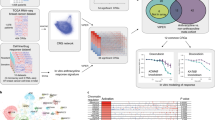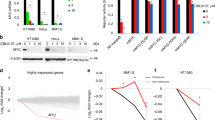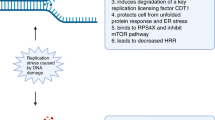Abstract
Many anticancer drugs induce DNA breaks to eliminate tumor cells. The anthracycline topoisomerase II inhibitors additionally cause histone eviction. Here, we performed genome-wide high-resolution mapping of chemotherapeutic effects of various topoisomerase I and II (TopoI and II) inhibitors and integrated this mapping with established maps of genomic or epigenomic features to show their activities in different genomic regions. The TopoI inhibitor topotecan and the TopoII inhibitor etoposide are similar in inducing DNA damage at transcriptionally active genomic regions. The anthracycline daunorubicin induces DNA breaks and evicts histones from active chromatin, thus quenching local DNA damage responses. Another anthracycline, aclarubicin, has a different genomic specificity and evicts histones from H3K27me3-marked heterochromatin, with consequences for diffuse large B-cell lymphoma cells with elevated levels of H3K27me3. Modifying anthracycline structures may yield compounds with selectivity for different genomic regions and activity for different tumor types.





Similar content being viewed by others
Accession codes
References
Arcamone, F.-M. Fifty years of chemical research at Farmitalia. Chemistry 15, 7774–7791 (2009).
Pang, B. et al. Drug-induced histone eviction from open chromatin contributes to the chemotherapeutic effects of doxorubicin. Nat. Commun. 4, 1908 (2013).
Yang, F., Kemp, C.J. & Henikoff, S. Doxorubicin enhances nucleosome turnover around promoters. Curr. Biol. 23, 782–787 (2013).
Jin, J. et al. Homoharringtonine-based induction regimens for patients with de-novo acute myeloid leukaemia: a multicentre, open-label, randomised, controlled phase 3 trial. Lancet Oncol. 14, 599–608 (2013).
ENCODE Project Consortium. An integrated encyclopedia of DNA elements in the human genome. Nature 489, 57–74 (2012).
Gerstein, M.B. et al. Architecture of the human regulatory network derived from ENCODE data. Nature 489, 91–100 (2012).
Nitiss, J.L. Targeting DNA topoisomerase II in cancer chemotherapy. Nat. Rev. Cancer 9, 338–350 (2009).
Pommier, Y. Topoisomerase I inhibitors: camptothecins and beyond. Nat. Rev. Cancer 6, 789–802 (2006).
Kundaje, A. et al. Ubiquitous heterogeneity and asymmetry of the chromatin environment at regulatory elements. Genome Res. 22, 1735–1747 (2012).
Kolasinska-Zwierz, P. et al. Differential chromatin marking of introns and expressed exons by H3K36me3. Nat. Genet. 41, 376–381 (2009).
Barski, A. et al. High-resolution profiling of histone methylations in the human genome. Cell 129, 823–837 (2007).
Trojer, P. & Reinberg, D. Facultative heterochromatin: is there a distinctive molecular signature? Mol. Cell 28, 1–13 (2007).
Gupta, J., Kumar, S., Li, J., Krishna Murthy Karuturi, R. & Tikoo, K. Histone H3 lysine 4 monomethylation (H3K4me1) and H3 lysine 9 monomethylation (H3K9me1): distribution and their association in regulating gene expression under hyperglycaemic/hyperinsulinemic conditions in 3T3 cells. Biochimie 94, 2656–2664 (2012).
Beck, D.B., Oda, H., Shen, S.S. & Reinberg, D. PR-Set7 and H4K20me1: at the crossroads of genome integrity, cell cycle, chromosome condensation, and transcription. Genes Dev. 26, 325–337 (2012).
Li, Z., Nie, F., Wang, S. & Li, L. Histone H4 Lys 20 monomethylation by histone methylase SET8 mediates Wnt target gene activation. Proc. Natl. Acad. Sci. USA 108, 3116–3123 (2011).
de Jong, J. et al. Chromatin landscapes of retroviral and transposon integration profiles. PLoS Genet. 10, e1004250 (2014).
Kuo, A.J. et al. NSD2 links dimethylation of histone H3 at lysine 36 to oncogenic programming. Mol. Cell 44, 609–620 (2011).
Cao, R. & Zhang, Y. SUZ12 is required for both the histone methyltransferase activity and the silencing function of the EED–EZH2 complex. Mol. Cell 15, 57–67 (2004).
Bernstein, B.E. et al. A bivalent chromatin structure marks key developmental genes in embryonic stem cells. Cell 125, 315–326 (2006).
Misteli, T. & Soutoglou, E. The emerging role of nuclear architecture in DNA repair and genome maintenance. Nat. Rev. Mol. Cell Biol. 10, 243–254 (2009).
Polo, S.E. & Jackson, S.P. Dynamics of DNA damage response proteins at DNA breaks: a focus on protein modifications. Genes Dev. 25, 409–433 (2011).
Sperling, A.S., Jeong, K.S., Kitada, T. & Grunstein, M. Topoisomerase II binds nucleosome-free DNA and acts redundantly with topoisomerase I to enhance recruitment of RNA Pol II in budding yeast. Proc. Natl. Acad. Sci. USA 108, 12693–12698 (2011).
Thakurela, S. et al. Gene regulation and priming by topoisomerase IIα in embryonic stem cells. Nat. Commun. 4, 2478 (2013).
Sneeringer, C.J. et al. Coordinated activities of wild-type plus mutant EZH2 drive tumor-associated hypertrimethylation of lysine 27 on histone H3 (H3K27) in human B-cell lymphomas. Proc. Natl. Acad. Sci. USA 107, 20980–20985 (2010).
Sparmann, A. & van Lohuizen, M. Polycomb silencers control cell fate, development and cancer. Nat. Rev. Cancer 6, 846–856 (2006).
McCabe, M.T. et al. EZH2 inhibition as a therapeutic strategy for lymphoma with EZH2-activating mutations. Nature 492, 108–112 (2012).
Jaffe, J.D. et al. Global chromatin profiling reveals NSD2 mutations in pediatric acute lymphoblastic leukemia. Nat. Genet. 45, 1386–1391 (2013).
Pang, B. et al. Direct antigen presentation and gap junction mediated cross-presentation during apoptosis. J. Immunol. 183, 1083–1090 (2009).
Staker, B.L. et al. The mechanism of topoisomerase I poisoning by a camptothecin analog. Proc. Natl. Acad. Sci. USA 99, 15387–15392 (2002).
Tewey, K.M., Rowe, T., Yang, L., Halligan, B. & Liu, L. Adriamycin-induced DNA damage mediated by mammalian DNA topoisomerase II. Science 226, 466–468 (1984).
Frederick, C.A. et al. Structural comparison of anticancer drug-DNA complexes: adriamycin and daunomycin. Biochemistry 29, 2538–2549 (1990).
Meuleman, W. et al. Constitutive nuclear lamina-genome interactions are highly conserved and associated with A/T-rich sequence. Genome Res. 23, 270–280 (2013).
Sehouli, J. et al. Nonplatinum topotecan combinations versus topotecan alone for recurrent ovarian cancer: results of a phase III study of the North-Eastern German Society of Gynecological Oncology Ovarian Cancer Study Group. J. Clin. Oncol. 26, 3176–3182 (2008).
Vey, N. et al. Combination of topotecan with cytarabine or etoposide in patients with refractory or relapsed acute myeloid leukemia: results of a randomized phase I/II study. Invest. New Drugs 17, 89–95 (1999).
Lin, C.Y. et al. Transcriptional amplification in tumor cells with elevated c-Myc. Cell 151, 56–67 (2012).
Timp, W. & Feinberg, A.P. Cancer as a dysregulated epigenome allowing cellular growth advantage at the expense of the host. Nat. Rev. Cancer 13, 497–510 (2013).
Sehn, L.H. A decade of R-CHOP. Blood 116, 2000–2001 (2010).
He, L.-R. et al. Prognostic impact of H3K27me3 expression on locoregional progression after chemoradiotherapy in esophageal squamous cell carcinoma. BMC Cancer 9, 461 (2009).
Cai, M.Y. et al. High expression of H3K27me3 in human hepatocellular carcinomas correlates closely with vascular invasion and predicts worse prognosis in patients. Mol. Med. 17, 12–20 (2011).
Holm, K. et al. Global H3K27 trimethylation and EZH2 abundance in breast tumor subtypes. Mol. Oncol. 6, 494–506 (2012).
Gaulton, K.J. et al. A map of open chromatin in human pancreatic islets. Nat. Genet. 42, 255–259 (2010).
Schmidt, D. et al. ChIP-seq: using high-throughput sequencing to discover protein–DNA interactions. Methods 48, 240–248 (2009).
Acknowledgements
We thank R. Kerkhoven, M. Nieuwland and A. Velds of the Netherlands Cancer Institute Genomic Core Facility; L. Janssen for support in cloning; and W. Akhtar, J. Gruber, B. van Steensel and P. Borst for their critical reading of the manuscript. This work was supported by a European Research Council grant to J.N. J.N. is a member of the Institute of Chemical Immunology.
Author information
Authors and Affiliations
Contributions
B.P. and J.N. designed experiments. X.Q. and B.P. performed experiments. J.d.J. designed and implemented the computational methods. J.d.J. and B.P. analyzed the data. B.P., J.d.J. and J.N. drafted the manuscript with input from all authors. J.N. and L.F.A.W. supervised the study and analyses.
Corresponding authors
Ethics declarations
Competing interests
The authors declare no competing financial interests.
Supplementary information
Supplementary Text and Figures
Supplementary Results, Supplementary Table 1, Supplementary Figures 1–19 and Supplementary Note. (PDF 18217 kb)
Supplementary Video 1
Histone dynamics in cells exposed to the TopoI inhibitor topotecan. (AVI 6394 kb)
Rights and permissions
About this article
Cite this article
Pang, B., de Jong, J., Qiao, X. et al. Chemical profiling of the genome with anti-cancer drugs defines target specificities. Nat Chem Biol 11, 472–480 (2015). https://doi.org/10.1038/nchembio.1811
Received:
Accepted:
Published:
Issue Date:
DOI: https://doi.org/10.1038/nchembio.1811
- Springer Nature America, Inc.
This article is cited by
-
The role of H3K27me3 methylation in cancer development
Genome Instability & Disease (2024)
-
Radiolabeled chemotherapeutics as a novel strategy for targeted cancer therapy: current insights and future perspectives
Journal of Radioanalytical and Nuclear Chemistry (2024)
-
The Bisdioxopiperazine ICRF-193 Attenuates LPS-induced IL-1β Secretion by Macrophages
Inflammation (2024)
-
Targeted CRISPR activation and knockout screenings identify novel doxorubicin transporters
Cellular Oncology (2023)
-
Therapeutic applications and biological activities of bacterial bioactive extracts
Archives of Microbiology (2021)





